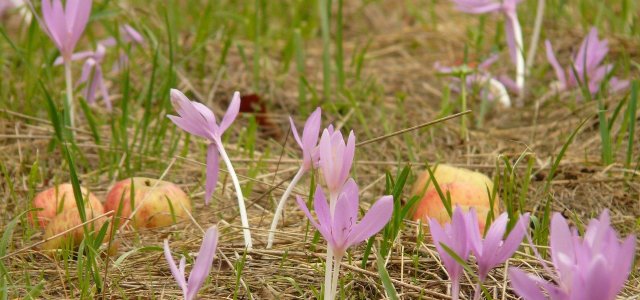
The autumn crocus is not only one of the most beautiful, but also one of the most poisonous native plants. Read here how to plant it in your garden and what makes it so poisonous.
When the summer bloomers slowly wilt, the blooming season of the autumn crocus begins. This beautiful flower blooms from August to October in pink, lilac and white and is a member of the timothy family. The plant is native to southern and central Europe and is a popular ornamental.
In 2010, autumn crocus was named Poisonous Plant of the Year because it contains a high concentration of the alkaloid colchicine.
Planting meadow saffron: location and procedure

If you want to plant autumn crocus in your garden, you should first choose a location suitable for them. The following points are important:
- Look for a sunny to maximum partial shade location. The more light, the more splendid the bloom.
- The location for the autumn crocus should be protected from the wind and warm.
- The plant thrives best in nutrient- and humus-rich soil. Read also: Soil test in the garden: What you should know.
- The soil should be permeable and loose.
Once you have found the ideal spot, you can start planting. The optimal time for this is between July and September – in the dormant season of the bulb flower.
By the way: To a certain extent you can influence when the autumn crocus blooms in your garden. As a rule of thumb, the flowers bloom about four weeks after you plant them.
Here’s how to do it:
Dig small planting holes for the bulbs in the appropriate location. The holes should be about ten to 20 centimeters deep. Also, leave about 20 centimeters of space between the individual bulbs so that they do not interfere with each other’s growth later on.
- Place the bulbs inside and fill the holes back up with soil.
- Press the soil down well and water the flowers.
- Proper care for autumn crocus
- Much to the delight of all amateur gardeners, autumn crocus is one of the easiest plants to care for.
You should only water the soil around it from time to time – especially if there are longer dry periods. However, the flower does not tolerate waterlogging.
- You do not need to fertilize meadow saffron.
- Dead, withered leaves should be plucked or cut off.
- Meadow saffron: Poisonous plant of the year 2010
As already mentioned, meadow saffron is one of the most poisonous native plants. The active ingredient colchicine, which is contained in all parts of the plant, is life-threatening or lethal for both humans and animals even in small quantities.
The pretty plant is therefore very unwelcome, especially in pastures. Adult cattle and horses avoid autumn crocus, but inexperienced young animals sometimes eat it. Consumption of autumn crocus – if the ingested amount of poison is sufficient – leads to respiratory paralysis, from which the animals die. It can also be dangerous for humans: The poison of the plant also remains in the hay and milk of the animals and thus enters the human organism.
Autumn crocus poison as a remedy
However, the poison of autumn crocus has not only negative, but also positive effects. In the right dosage it helps in acute attacks of gout. Colchicine interferes with white blood cells migrating directly to the inflammatory focus in the body.
However, side effects also accompany the use of colchicine. Problems with the gastrointestinal tract are common. These include diarrhea, nausea, abdominal pain, and vomiting.


